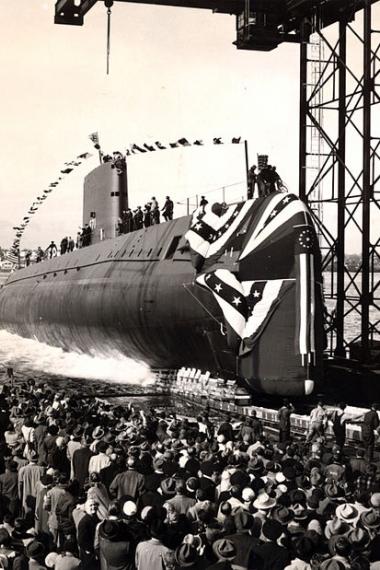
Unanchoring the Navy
THE SOURCE: “Sea Change” by Ronald Spector, in The Quarterly Journal of Military History, Winter 2012.

THE SOURCE: “Sea Change” by Ronald Spector, in The Quarterly Journal of Military History, Winter 2012.
In its uniforms, ranks, and lexicon, the U.S. Navy retains the trappings of an earlier era. One could be forgiven for thinking of it as a “traditional, even reactionary” organization, writes Ronald Spector, a historian at George Washington University. That would be mistaken. Over the last century, the Navy engaged in a “seemingly endless process of reinvention” in response to changes in technology and warfare. Dreadnoughts, airplanes, and nuclear submarines all brought disruptive change. But thanks to titanic efforts of will—and encouragement from unique figures—the Navy switched course successfully.
The early-20th-century steel-hulled dreadnought, propelled by a steam turbine and better armed than its wind-powered predecessors, presented the first modern challenge. Dreadnoughts required a larger and better-trained maritime force. President Woodrow Wilson’s secretary of the Navy, Josephus Daniels, wanted the new American sailor to be “a sort of well-traveled, high-tech Boy Scout,” Spector writes. In 1916, Daniels—a Progressive newspaperman with no military background—ordered that all sailors receive two hours of daily instruction. He also improved shipboard life with perks such as laundry service and ice cream. Some officers balked, but Daniels was vindicated. The number and quality of men in the Navy rose. Their image as “rakish adventurers” went the way of the sail.
Aviation, which began to have a place in the naval mission after World War I, introduced new problems. The Navy vastly expanded its airpower, but soon faced a shortage of pilots. It responded by enabling civilians to become commissioned Navy Reserve pilots after just a year of training. The program played a crucial role in World War II; most of the Navy pilots who fought the Axis were not lifers. “For the first time in 20th-century naval history,” Spector says, “a major, potentially decisive mode of warfare had been largely entrusted to a body of noncareer, short-service officers.”
After the war, nuclear technology stirred the pot again. In 1954, the Navy launched the Nautilus, its first nuclear submarine. Like dreadnoughts, these pioneering subs required a new sort of sailor. Admiral Hyman Rickover oversaw the creation of the nuclear service, which became an influential “navy within the navy.” Rickover’s intensity and eye for detail were legendary. He personally interrogated every prospective “nucs” officer. Those who passed muster faced intensive schooling and a tour of training at a nuclear reactor in Idaho. Old-timers grumbled, but the “nucs” thrived. By the 1970s, they accounted for a major part of the admiralty.
Spector says naval reinvention will continue. In 2010, the Navy launched its Fleet Cyber Command—designed to wage war over the Web as well as the waves. “This is only the latest in a series of radical transformations,” Spector writes, “that have reshaped the American sailor’s trade over the last hundred years.”
Follow the WQ on Facebook and Twitter.
Photo credit: The nuclear-powered USS Nautilus in 1954 by the U.S. Navy via creative commons.